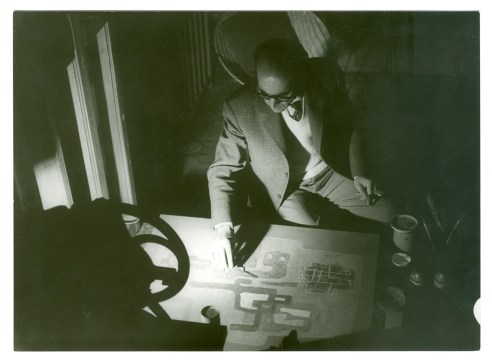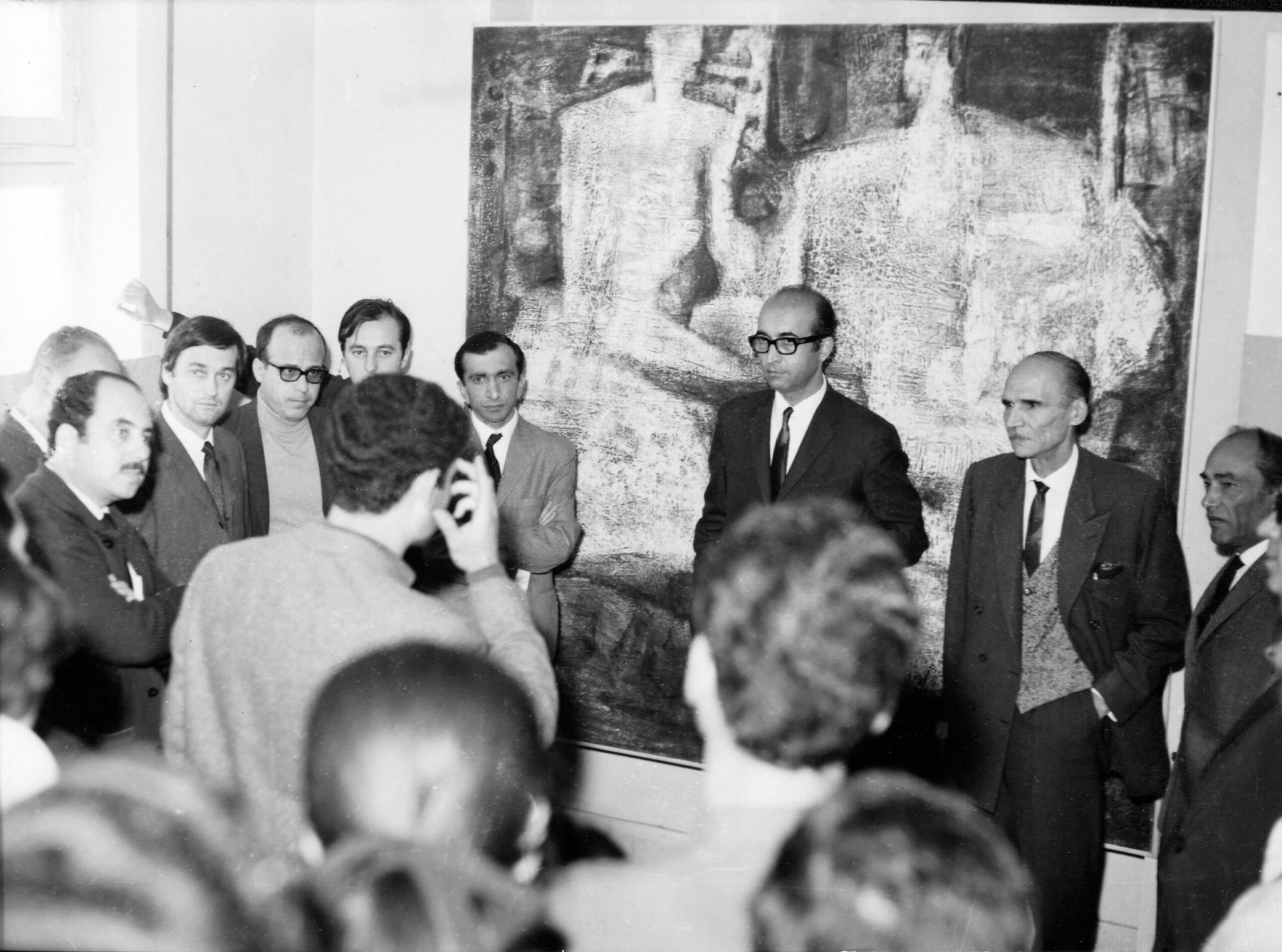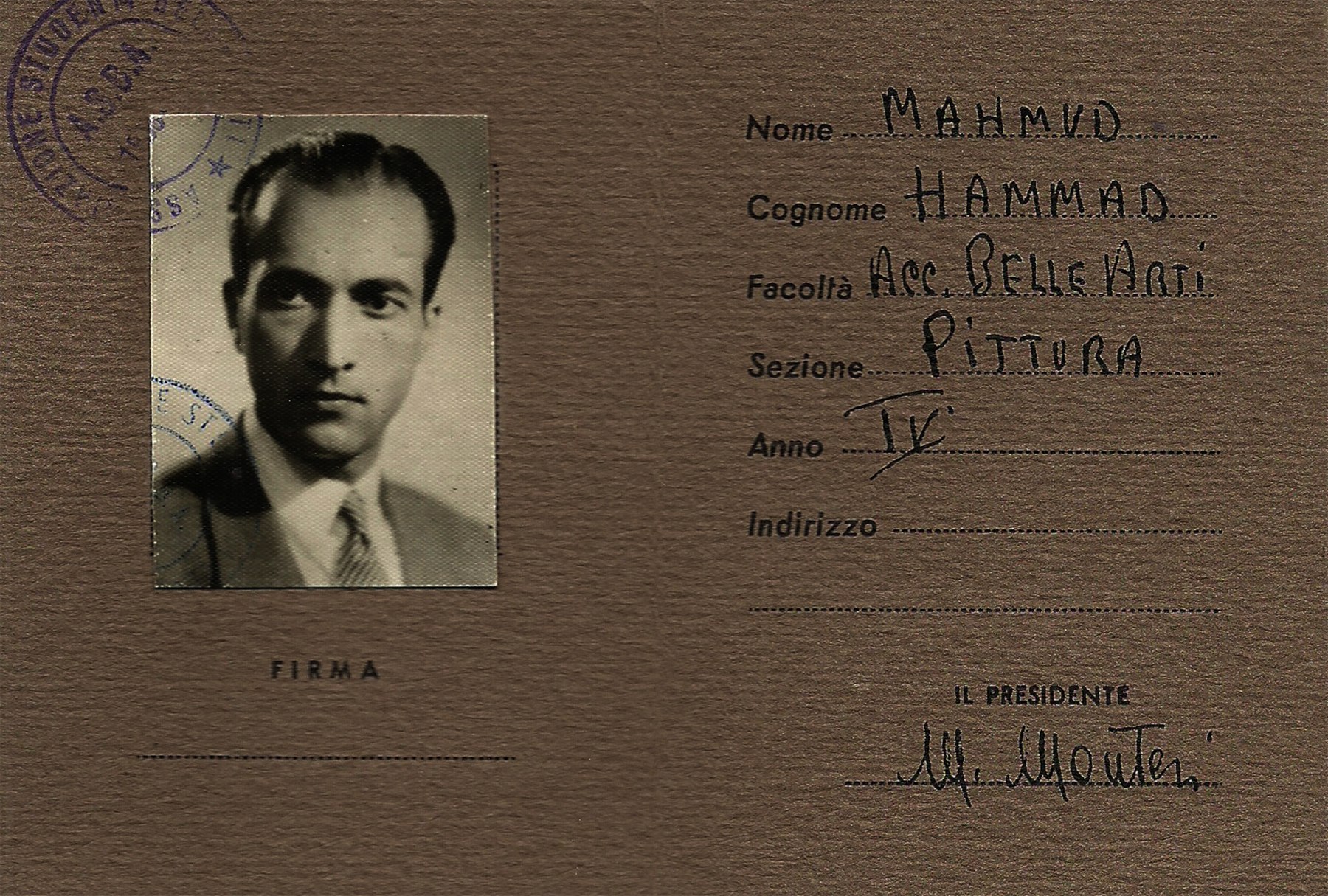

Mahmoud Hammad at th Faculty of Fine Arts in Damscus, 1965
FORWARD
The documentation of an artist’s life and oeuvre cannot be complete without contextualising how these were affected by the era in which they lived. One must survey the general art scene of their time, including its trends, experiments, and adventures, since the artist – regardless of how unique – is part and parcel of an artistic movement, both influencing it and influenced by it. I reached this conclusion when researching the extensive archive left behind by my father. It is rich in works from different eras of his life, and includes sketches, notes, and correspondence as well as ephemera from journeys, exhibitions and his experience teaching art, along with photographs taken with his contemporaries, both artists and writers, and his thoughts on events in Syria.
My father’s studio occupied a significant space in our house, which was situated in one of Damascus’ old neighbourhoods. Since an early age, I would observe him fully immersed in working on a painting, either standing at his easel, preoccupied with colours and lines, like a passionate lover, or sitting at his desk sketching designs, writing down notes or reading a book. This studio was a weekly meeting place for a group of his friends, who were artists and writers. These gatherings were full of in-depth dialogues and exchanges, as well as humour and jokes, in an atmosphere of true amiability and friendship.
My father was always keen on documenting all his work and activities, as well as archiving it in folders. This has helped me immensely once I started the task of collecting and classifying it all in an effort to create a comprehensive archive that is intended to be a legacy for the coming generation and shed the light on an important era in the history of art, not only in Syria, but also in the world.
On one of my visits to Damascus in 2010, I discussed with my brother Amin the importance of archiving and documenting the work of our father, as well as the potential ways to preserve and maintain his artistic legacy.We had at hand, many artworks attributed to different stages of his professional career using various media over a period of more than 50 years. First, we categorised the works into four eras: Beginnings (1939–1953); Rome (1953–1957 where he studied art academically); Hauran (1957–1963); and lastly Abstract Hurufiyya,spanning the time from 1963 until his death in 1988 – it was this last era that defined his career. Then, with the aim of creating a digital archive, we took high-resolution photographs of all the paintings, large works on paper and medals which we found in the studio.
Based on the aforementioned four eras, we organised the paper archive into different folders for drawings, studies, designs of logos, stamps and book and magazine covers, including designs and drawings for the magazines of Al Jundi (The Soldier) and Al Tibgh (The Tobacco) from the 1950s.
We also preserved all documents, including personal and official letters, photographs, exhibition booklets, educational materials, articles, and translations by him. We also found texts in artist Adham Ismail’s handwriting documenting the diaries of his journey with my father from Rome to Andalusia in 1955, complete with their observations, anecdotes, and some illustrations.
Lastly, we collected and scanned all publications and printed material – such as newspaper and magazine interviews. We also scanned all photographs, slides, and negatives. Worth noting is that Hammad used to photograph his artworks once he was done with them, and even had a dark room at home to develop and print his photographs. Furthermore, we digitised all videos in which there were interviews with Hammad or other contemporaries such as Nassir Shoura, Naim Ismail and Elias Zayat – these had been broadcast on Syrian TV.
We also found records and lists in which Hammad had documented the artworks he completed each year, the galleries in which they were exhibited, and other details, including prices and buyers, as well other important data that has provided a more accurate and comprehensive archive of his output.
Upon examination, we found out that most of the artworks from the eras Beginnings, Hauran and Hurufiyyawere numbered, either in his own registry or on the back of the paintings themselves. This enabled us to identify missing works from the archive, as well as to document works attributed to Hammad. In total, we documented some 4,600 paintings, drawings, and studies on paper.
Photographs, correspondence, records, publications and catalogues act as important documentation of events in Syria, Rome and other places. These include the establishment of the first art associations in Damascus in the 1940s and 1950s, and his years studying in Rome with several Arab artists who, later, enjoyed a prominent presence in the local, Arab, and international art scene.
Entries from the 1960s, 1970s and 1980s provide crucial information about the establishment of The Faculty of Fine Arts in Damascus, its curriculum and visiting professors. Also featured in these entries is information on the First Arab Conference of Fine Arts, held in Damascus in 1971, followed by the First Conference of the General Union of Arab Plastic Artists, organised in Baghdad in 1973, and other milestones documenting the history of modern art in Syria.
Thus, this archive is, in fact, a tribute to those pioneering artists whose collective efforts and ideas did not revive only Syrian art, but also Arab art as a wider whole: they all shared the same struggles, working in challenging cultural and economic settings during the inter-war period. After lagging behind during the period of colonialisation and foreign mandate, the concerted efforts of these artists were focused on catching up with the European and international art scenes, maturing over the years to bring about the modern art movement in the Middle East.
In addition to our historical and documentary objectives, we must mention the personal dimension. Working on this archive introduced me to previously unknown facets of my father’s character and brought back memories of events I witnessed and still yearn for.
The documentation of an artist’s life and oeuvre cannot be complete without contextualising how these were affected by the era in which they lived. One must survey the general art scene of their time, including its trends, experiments, and adventures, since the artist – regardless of how unique – is part and parcel of an artistic movement, both influencing it and influenced by it. I reached this conclusion when researching the extensive archive left behind by my father. It is rich in works from different eras of his life, and includes sketches, notes, and correspondence as well as ephemera from journeys, exhibitions and his experience teaching art, along with photographs taken with his contemporaries, both artists and writers, and his thoughts on events in Syria.
My father’s studio occupied a significant space in our house, which was situated in one of Damascus’ old neighbourhoods. Since an early age, I would observe him fully immersed in working on a painting, either standing at his easel, preoccupied with colours and lines, like a passionate lover, or sitting at his desk sketching designs, writing down notes or reading a book. This studio was a weekly meeting place for a group of his friends, who were artists and writers. These gatherings were full of in-depth dialogues and exchanges, as well as humour and jokes, in an atmosphere of true amiability and friendship.
My father was always keen on documenting all his work and activities, as well as archiving it in folders. This has helped me immensely once I started the task of collecting and classifying it all in an effort to create a comprehensive archive that is intended to be a legacy for the coming generation and shed the light on an important era in the history of art, not only in Syria, but also in the world.
On one of my visits to Damascus in 2010, I discussed with my brother Amin the importance of archiving and documenting the work of our father, as well as the potential ways to preserve and maintain his artistic legacy.We had at hand, many artworks attributed to different stages of his professional career using various media over a period of more than 50 years. First, we categorised the works into four eras: Beginnings (1939–1953); Rome (1953–1957 where he studied art academically); Hauran (1957–1963); and lastly Abstract Hurufiyya,spanning the time from 1963 until his death in 1988 – it was this last era that defined his career. Then, with the aim of creating a digital archive, we took high-resolution photographs of all the paintings, large works on paper and medals which we found in the studio.
Based on the aforementioned four eras, we organised the paper archive into different folders for drawings, studies, designs of logos, stamps and book and magazine covers, including designs and drawings for the magazines of Al Jundi (The Soldier) and Al Tibgh (The Tobacco) from the 1950s.
We also preserved all documents, including personal and official letters, photographs, exhibition booklets, educational materials, articles, and translations by him. We also found texts in artist Adham Ismail’s handwriting documenting the diaries of his journey with my father from Rome to Andalusia in 1955, complete with their observations, anecdotes, and some illustrations.
Lastly, we collected and scanned all publications and printed material – such as newspaper and magazine interviews. We also scanned all photographs, slides, and negatives. Worth noting is that Hammad used to photograph his artworks once he was done with them, and even had a dark room at home to develop and print his photographs. Furthermore, we digitised all videos in which there were interviews with Hammad or other contemporaries such as Nassir Shoura, Naim Ismail and Elias Zayat – these had been broadcast on Syrian TV.
We also found records and lists in which Hammad had documented the artworks he completed each year, the galleries in which they were exhibited, and other details, including prices and buyers, as well other important data that has provided a more accurate and comprehensive archive of his output.
Upon examination, we found out that most of the artworks from the eras Beginnings, Hauran and Hurufiyyawere numbered, either in his own registry or on the back of the paintings themselves. This enabled us to identify missing works from the archive, as well as to document works attributed to Hammad. In total, we documented some 4,600 paintings, drawings, and studies on paper.
Photographs, correspondence, records, publications and catalogues act as important documentation of events in Syria, Rome and other places. These include the establishment of the first art associations in Damascus in the 1940s and 1950s, and his years studying in Rome with several Arab artists who, later, enjoyed a prominent presence in the local, Arab, and international art scene.
Entries from the 1960s, 1970s and 1980s provide crucial information about the establishment of The Faculty of Fine Arts in Damascus, its curriculum and visiting professors. Also featured in these entries is information on the First Arab Conference of Fine Arts, held in Damascus in 1971, followed by the First Conference of the General Union of Arab Plastic Artists, organised in Baghdad in 1973, and other milestones documenting the history of modern art in Syria.
Thus, this archive is, in fact, a tribute to those pioneering artists whose collective efforts and ideas did not revive only Syrian art, but also Arab art as a wider whole: they all shared the same struggles, working in challenging cultural and economic settings during the inter-war period. After lagging behind during the period of colonialisation and foreign mandate, the concerted efforts of these artists were focused on catching up with the European and international art scenes, maturing over the years to bring about the modern art movement in the Middle East.
In addition to our historical and documentary objectives, we must mention the personal dimension. Working on this archive introduced me to previously unknown facets of my father’s character and brought back memories of events I witnessed and still yearn for.
Lubna Hammad
March 27, 2023

Identification card from the Academy of Fine Arts. Rome, 1956-57
TECHNICAL REPORT
In line with our aim to document and enhance the exchange of knowledge, Mahmoud Hammad’s archive is the second collection of modern Syrian art for which we take upon ourselves the responsibility to work on and publish. Through his daughter Lubna and his son Amin, we reached an agreement with Mahmoud Hammad family, and gained access to significant material on the history of Syrian art.
Hammad was not only an exceptional artist and one of the prominent founding figures of the Syrian art scene – especially in regard to the abstract and Hurufiyya movements of his oeuvre – he was also one of the notable co-founders of The Faculty of Fine Arts, helping out on the administrative front as well as being involved in the development of the curriculum. He was also Dean between 1970 and 1980. The richness of his personal, artistic and educational expertise bestowed upon this archive an important documentational dimension that has allowed us to survey the artistic, educational, social and historic scene related to the life of artists.
The oldest document dates back to 1924, while the most recent is from 1988, i.e., spanning from when Mahmoud Hammad was one year old up until his death. There are eight main folders – Documents (172), Letters (43), Manuscripts (57), Monuments (259), photographs (795), Postcards (109), Clippings (128) and Writings (28) – which shows the importance of this archive on three levels: the historical importance of cultural value, the intellectual importance of scientific value and the artistic importance of a personal dimension.
THE FOLDERS
Documents: was divided into three sub-folders:
Certificates from Rome (1935–1957): All kinds of identification papers and certificates Mahmoud Hammad had while studying in Italian schools in Damascus and later living in Rome.
Letters and Official Documents (1944–1988): Written correspondence between Hammad and official Syrian, Arab and foreign entities, his administrative decisions when he was the dean of the Faculty of Fine Arts in Damascus, and other official documents.
Personal Documents (1925–1982): Identity and personal cards, including professional affiliations, licenses and certificates.
Letters (1923–1987): Includes letters taken out from the Letters and Official Documents sub-folder. These are exchanges related to Hammad’s family and personal lives, and friendships.
Manuscripts: Includes texts handwritten by Hammad as drafts for articles, lectures, interviews, translations and scientific reports as well as texts by other writers. The reason behind grouping these texts under this category regardless of their nature ( official or private) is our inability to verify whether they have been published as they are or not, and whether they have been edited or their content changed. No information was available related to the publishers.
Monuments: Includes seven sub-folders that contain documents and photographs relating to monumental works designed by Hammad (both executed and unexecuted works). The photos in these sub-folders vary from documentation to photos of executed works, sculpture scale models, digital copies of blueprints and perspectives and sketches.
Photographs: This is the largest folder in Hammad’s archives, and thus we divided it into decades, starting from the 1920s through to the 1980s. Each sub-folder consists of album-style smaller folders based on the technical description of the photographs. Due to the sheer number of photographs, we can only publish part of them.
Postcards: Consists of a large number of postcards sent to Hammad by friends and colleagues, including artists and Syrian, Arab and foreign professors from their countries or places they visited.
Clippings: Includes journalistic writings and critiques published in Arab and foreign newspapers and magazines, and related to Hammad’s artistic practice. This folder is of great importance as it portrays the cultural movement and the level of art criticism in each relevant time period. This folder also includes interviews with other artists or writings about them. Thus, the folder is relevant to the history of Syrian art in general, and Mahmoud Hammad in particular, and has been divided according to publication years.
Writings: includes some of the writings and translations of Mahmoud Hammad, as well as a small number of his published articles. Despite the relatively small number of documents in comparison to Hammad’s overall written output, this folder is of great intellectual importance, and is limited to the material that was available to archive owners.
Art work images and catalogues will be published at a later date.
Due to the sheer scale of this archive, we have created a reference guide to help navigate it, including categorisation and content through hierarchical structure and description lists. We also included a glossary of names of artists and writers mentioned in the archive (amendable upon the request of the owners of the rights).
Researchers and scholars are invited to contact us in relation to the un-published parts of the archives mentioned in the manual.
Nour Asalia and Shireen Atassi
April 10, 2023
Please note that this archive is copyright protected. To read more about our terms and conditions please visit:https://www.atassifoundation.com/terms-of-use
In order to access documents that are not published on the website you may contact us via e-mail.